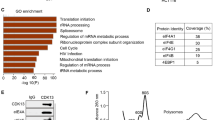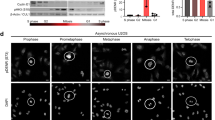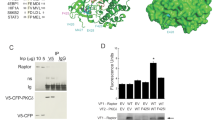Abstract
There is currently substantial interest in the regulation of cell function by mammalian target of rapamycin (mTOR), especially effects linked to the rapamycin-sensitive mTOR complex 1 (mTORC1). Rapamycin induces G1 arrest and blocks proliferation of many tumor cells, suggesting that the inhibition of mTORC1 signaling may be useful in cancer therapy. In MCF7 breast adenocarcinoma cells, rapamycin decreases levels of cyclin D1, without affecting cytoplasmic levels of its mRNA. In some cell–types, rapamycin does not affect cyclin D1 levels, whereas the starvation for leucine (which impairs mTORC1 signaling more profoundly than rapamycin) does. This pattern correlates with the behavior of eukaryotic initiation factor 4E-binding protein 1 (4E-BP1, an mTORC1 target that regulates translation initiation). siRNA-mediated knock-down of 4E-BP1 abrogates the effect of rapamycin on cyclin D1 expression and increases the polysomal association of the cyclin D1 mRNA. Our data identify 4E-BP1 as a key regulator of cyclin D1 expression, indicate that this effect is not mediated through the changes in cytoplasmic levels of cyclin D1 mRNA and suggest that, in some cell types, interfering with the amino acid input to mTORC1, rather than using rapamycin, may inhibit proliferation.
This is a preview of subscription content, access via your institution
Access options
Subscribe to this journal
Receive 50 print issues and online access
$259.00 per year
only $5.18 per issue
Buy this article
- Purchase on Springer Link
- Instant access to full article PDF
Prices may be subject to local taxes which are calculated during checkout





Similar content being viewed by others
Abbreviations
- 4E-BP1:
-
eIF4E-binding protein 1
- eIF:
-
eukaryotic initiation factor
- m7GTP:
-
7-methyl GTP
- mTOR:
-
mammalian target of rapamycin
- mTORC:
-
mTOR complex
- S6K:
-
S6 kinase
References
Albers MW, Williams RT, Brown EJ, Tanaka A, Hall FL, Schreiber SL . (1993). FKBP-rapamycin inhibits a cyclin-dependent kinase activity and a cyclin D1-Cdk association in early G1 of an osteosarcoma cell line. J Biol Chem 268: 22825–22829.
Averous J, Maurin AC, Bruhat A, Jousse C, Arliguie C, Fafournoux P . (2005). Induction of IGFBP-1 expression by amino acid deprivation of HepG2 human hepatoma cells involves both a transcriptional activation and an mRNA stabilization due to its 3′UTR. FEBS Lett 579: 2609–2614.
Averous J, Proud CG . (2006). When translation meets transformation: the mTOR story. Oncogene 25: 6423–6435.
Bruhat A, Jousse C, Wang XZ, Ron D, Ferrara M, Fafournoux P . (1997). Amino acid limitation induces expression of CHOP, a CCAAT/enhancer binding protein-related gene, at both transcriptional and post-transcriptional levels. J Biol Chem 272: 17588–17593.
Corradetti MN, Guan KL . (2006). Upstream of the mammalian target of rapamycin: do all roads pass through mTOR? Oncogene 25: 6347–6360.
De Benedetti A, Graff JR . (2004). eIF-4E expression and its role in malignancies and metastases. Oncogene 23: 3189–3199.
Dostie J, Ferraiuolo M, Pause A, Adam SA, Sonenberg N . (2000). A novel shuttling protein, 4E-T, mediates the nuclear import of the mRNA 5′ cap-binding protein, eIF4E. EMBO J 19: 3142–3156.
Easton JB, Houghton PJ . (2006). mTOR and cancer therapy. Oncogene 25: 6436–6446.
Gera JF, Mellinghoff IK, Shi Y, Rettig MB, Tran C, Hsu JH et al. (2004). AKT activity determines sensitivity to mammalian target of rapamycin (mTOR) inhibitors by regulating cyclin D1 and c-myc expression. J Biol Chem 279: 2737–2746.
Gingras A-C, Raught B, Gygi SP, Niedzwieka A, Miron M, Burley SK et al. (2001). Hierarchical phosphorylation of the translation inhibitor 4E-BP1. Genes Dev 15: 2852–2864.
Guan L, Song K, Pysz MA, Curry KJ, Hizli AA, Danielpour D et al. (2007). Protein kinase C-mediated down-regulation of cyclin D1 involves activation of the translational repressor 4E-BP1 via a phosphoinositide 3-kinase/Akt-independent, protein phosphatase 2A-dependent mechanism in intestinal epithelial cells. J Biol Chem 282: 14213–14225.
Hashemolhosseini S, Nagamine Y, Morley SJ, Desrivieres S, Mercep L, Ferrari S . (1998). Rapamycin inhibition of the G1 to S transition is mediated by effects on cyclin d1 mRNA and protein stability. J Biol Chem 273: 14424–14429.
Hizli AA, Black AR, Pysz MA, Black JD . (2006). Protein kinase C alpha signaling inhibits cyclin D1 translation in intestinal epithelial cells. J Biol Chem 281: 14596–14603.
Holz MK, Ballif BA, Gygi SP, Blenis J . (2005). mTOR and S6K1 mediate assembly of the translation preinitiation complex through dynamic protein interchange and ordered phosphorylation events. Cell 123: 569–580.
Jiang H, Coleman J, Miskimins R, Miskimins WK . (2003). Expression of constitutively active 4EBP-1 enhances p27Kip1 expression and inhibits proliferation of MCF7 breast cancer cells. Cancer Cell Int 3: 2.
Kimball SR, Jefferson LS . (2006). Signaling pathways and molecular mechanisms through which branched-chain amino acids mediate translational control of protein synthesis. J Nutr 136: 227S–231S.
Koziczak M, Hynes NE . (2004). Cooperation between fibroblast growth factor receptor-4 and ErbB2 in regulation of cyclin D1 translation. J Biol Chem 279: 50004–50011.
Lazaris-Karatzas A, Sonenberg N . (1992). The mRNA 5′ cap-binding protein, eIF-4E, cooperates with v-myc or E1A in the transformation of primary rodent fibroblasts. Mol Cell Biol 12: 1234–1238.
Mamane Y, Petroulakis E, Le Bacquer O, Sonenberg N . (2006). mTOR, translation initiation and cancer. Oncogene 25: 6416–6422.
Moerke NJ, Aktas H, Chen H, Cantel S, Reibarkh MY, Fahmy A et al. (2007). Small-molecule inhibition of the interaction between the translation initiation factors eIF4E and eIF4G. Cell 128: 257–267.
Peng T, Golub TR, Sabatini DM . (2002). The immunosuppressant rapamycin mimics a starvation-like signal distinct from amino acid and glucose deprivation. Mol Cell Biol 21: 5575–5584.
Raught B, Gingras A-C, Sonenberg N . (2001). The target of rapamycin (TOR) proteins. Proc Natl Acad Sci USA 98: 7037–7044.
Rosenwald IB, Lazaris-Karatzas A, Sonenberg N, Schmidt EV . (1993). Elevated levels of cyclin D1 protein in response to increased expression of eukaryotic initiation factor 4E. Mol Cell Biol 13: 7358–7363.
Rousseau D, Kaspar R, Rosenwald I, Gehrke L, Sonenberg N . (1996). Translation initiation of ornithine decarboxylase and nucleocytoplasmic transport of cyclin D1 messenger-RNA are increased in cells overexpressing eukaryotic initiation factor 4E. Proc Natl Acad Sci USA 93: 1065–1070.
Ruggero D, Montanaro L, Ma L, Xu W, Londei P et al. (2004). The translation factor eIF-4E promotes tumor formation and cooperates with c-Myc in lymphomagenesis. Nat Med 10: 484–486.
Sabatini DM . (2006). mTOR and cancer: insights into a complex relationship. Nat Rev Cancer 6: 729–734.
Shahbazian D, Roux PP, Mieulet V, Cohen MS, Raught B, Taunton J et al. (2006). The mTOR/PI3K and MAPK pathways converge on eIF4B to control its phosphorylation and activity. EMBO J 25: 2781–2791.
Tee AR, Proud CG . (2002). Caspase cleavage of initiation factor 4E-binding protein 1 yields a dominant inhibitor of cap-dependent translation and reveals a novel regulatory motif. Mol Cell Biol 22: 1674–1683.
Wang X, Beugnet A, Murakami M, Yamanaka S, Proud CG . (2005). Distinct signaling events downstream of mTOR cooperate to mediate the effects of amino acids and insulin on initiation factor 4E-binding proteins. Mol Cell Biol 25: 2558–2572.
Wullschleger S, Loewith R, Hall MN . (2006). TOR signaling in growth and metabolism. Cell 124: 471–484.
Acknowledgements
We thank Dr Maria Buxadé and Dr Josep Parra for helpful discussions and advice. We are grateful to Dr Herman Ziltener and Dr Klaus Gossens for access to the Light-Cycler. This work was supported by funding from AstraZeneca. BDF gratefully acknowledges support from the Morton Trust/Dundee School of Life Sciences Alumnus Fund.
Author information
Authors and Affiliations
Corresponding author
Additional information
Supplementary Information accompanies the paper on the Oncogene website (http://www.nature.com/onc).
Supplementary information
Rights and permissions
About this article
Cite this article
Averous, J., Fonseca, B. & Proud, C. Regulation of cyclin D1 expression by mTORC1 signaling requires eukaryotic initiation factor 4E-binding protein 1. Oncogene 27, 1106–1113 (2008). https://doi.org/10.1038/sj.onc.1210715
Received:
Revised:
Accepted:
Published:
Issue Date:
DOI: https://doi.org/10.1038/sj.onc.1210715
Keywords
This article is cited by
-
The gene expression profile and cell of origin of canine peripheral T-cell lymphoma
BMC Cancer (2024)
-
miR-483-5p orchestrates the initiation of protein synthesis by facilitating the decrease in phosphorylated Ser209eIF4E and 4E-BP1 levels
Scientific Reports (2024)
-
Targeting mTOR to overcome resistance to hormone and CDK4/6 inhibitors in ER-positive breast cancer models
Scientific Reports (2023)
-
Overexpressed Cyclin D1 and CDK4 proteins are responsible for the resistance to CDK4/6 inhibitor in breast cancer that can be reversed by PI3K/mTOR inhibitors
Science China Life Sciences (2023)
-
Targeting CDK4 and CDK6 in cancer
Nature Reviews Cancer (2022)



